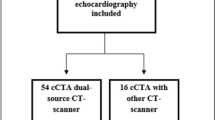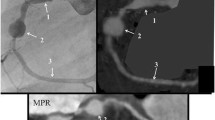Abstract
Background
Kawasaki disease (KD) is a systemic vasculitis that mainly affects coronary arteries in children, and requires regular follow-up from the time of diagnosis.
Objective
To evaluate the feasibility of 64-slice CT angiography (CTA) for follow-up of patients with KD using previously performed invasive catheter coronary angiography (CCA) as reference standard.
Materials and methods
The study group comprised 12 patients (age 17.6 ± 2.9 years, mean±SD) with a diagnosis of KD and a previously performed CCA (interval, 32.6 ± 13.5 months) who underwent 64-slice cardiac CTA. The quality of the images for establishing the presence of coronary abnormalities was determined by two observers. The CTA findings were compared with those from the prior CCA.
Results
Adequate image quality was obtained in all patients. Mean effective dose for CTA was 6.56 ± 0.95 mSv. CTA allowed accurate identification, characterization and measurement of all coronary aneurysms (n = 32), stenoses (n = 3) and occlusions (n = 9) previously demonstrated by CCA. One patient with disease progression went on to have percutaneous coronary intervention.
Conclusion
Coronary lesions were reliably evaluated by 64-slice CTA in the follow-up of compliant patients with KD, reducing the need for repeated diagnostic invasive CCA. Hence, in an adequately selected patient population, the role of CCA could be limited almost only to therapeutic procedures.






Similar content being viewed by others
References
Mandell BF, Hoffman GS (2005) Rheumatic diseases and the cardiovascular system: vasculitis: Kawasaki disease. In: Zipes DP, Libby P, Bonow RO, Braunwald E (eds) Braunwald’s heart disease: a textbook of cardiovascular medicine, 7th edn. Elsevier Saunders, Philadelphia, PA, pp 2105–2106
Freeman AF, Shulman ST (2006) Kawasaki disease: summary of the American Heart Association Guidelines. Am Fam Physician 74:1141–1148
Jamshidi N, Abbaszadeh A, Kalyani MN (2009) Effects of video information on anxiety, stress and depression of patients undergoing coronary angiography. Pak J Med Sci 25:901–905
Janne D’Othèe B, Siebert U, Cury R et al (2008) A systematic review on diagnostic accuracy of CT-based detection of significant coronary artery disease. Eur J Radiol 65:449–461
Herzog C, Zwerner PL, Doll JR et al (2007) Significant coronary artery stenosis: comparison on per-patient and per-vessel or per-segment basis at 64-section CT angiography. Radiology 244:112–120
Poll LW, Cohnen M, Brachten S et al (2002) Dose reduction in multi-slice CT of the heart by use of ECG-controlled tube current modulation (“ECG pulsing”): phantom measurements. Rofo 174:1500–1505
Mulkens TH, Bellinck P, Baeyaert M et al (2005) Use of an automatic exposure control mechanism for dose optimization in multi-detector row CT examinations: clinical evaluation. Radiology 237:213–223
Detre KM, Wright E, Murphy ML et al (1975) Observer agreement in evaluating coronary angiograms. Circulation 52:979–986
Ministry of Health and Welfare (1984) Report of the Subcommittee on Standardization of Siagnostic Criteria and Reporting of Coronary Artery Lesions in Kawasaki Disease. Research Committee on Kawasaki disease, Ministry of Health and Welfare, Tokyo
Dajani AS, Taubert KA, Takahashi M et al (1994) Guidelines for long-term management of patients with Kawasaki disease. Report from the Committee on Rheumatic Fever, Endocarditis, and Kawasaki Disease, Council on Cardiovascular Disease in the Young. Am Heart Assoc Circ 89:916–922
Fleiss JL (1981) Statistical methods for rates and proportions. 2nd ed. Wiley, New York, pp 212–236
Kanamaru H, Sato Y, Takayama T et al (2005) Assessment of coronary artery abnormalities by multislice spiral computed tomography in adolescents and young adults with Kawasaki disease. Am J Cardiol 95:522–525
Sato Y, Kato M, Inoue F et al (2003) Detection of coronary artery aneurysms, stenoses and occlusions by multislice spiral computed tomography in adolescents with Kawasaki disease. Circ J 67:427–430
Aggarwala G, Iyengar N, Burke SJ et al (2006) Kawasaki disease: role of coronary CT angiography. Int J Cardiovasc Imaging 22:803–805
Sohn S, Kim HS, Lee SW (2004) Multidetector row computed tomography for follow up of patients with coronary artery aneurysms due to Kawasaki disease. Pediatr Cardiol 25:35–39
Peng Y, Zeng J, Du Z et al (2009) Usefulness of 64-slice MDCT for follow-up of young children with coronary artery aneurysm due to Kawasaki disease: initial experience. Eur J Radiol 69:500–509
Xing Y, Wang H, Yu X et al (2009) Assessment of coronary artery lesions in children with Kawasaki disease: evaluation of MSCT in comparison with 2-D echocardiography. Pediatr Radiol 39:1209–1215
Chu W, Mok G, Lam W et al (2006) Assessment of coronary artery aneurysms in paediatric patients with Kawasaki disease by multidetector row CT angiography: feasibility and comparison with 2D echocardiography. Pediatr Radiol 36:1148–1153
Chao B, Wang X, Wu L et al (2010) Diagnostic value of dual source CT in Kawasaki disease. Chin Med J 123:670–674
Wilde P, Pitcher EM, Slack K (2001) Radiation hazards for the patient in cardiological procedures. Heart 85:127–130
De Bono D (1993) Complications of diagnostic cardiac catheterisation: results from 34,041 patients in the United Kingdom confidential enquiry into cardiac catheter complications. The Joint Audit Committee of the British Cardiac Society and Royal College of Physicians of London. Br Heart J 70:297–300
Deetjen A, Möllmann S, Conradi G et al (2007) Use of automatic exposure control in multislice computed tomography of the coronaries: comparison of 16-slice and 64-slice scanner data with conventional coronary angiography. Heart 93:1040–1043
Goo HW, Park IS, Ko JK et al (2006) Coronary CT angiography and MR angiography in Kawasaki disease. Pediatr Radiol 36:697–705
Maruyama T, Takada M, Hasuike T et al (2008) Radiation dose reduction and coronary assessability of prospective electrocardiogram-gated computed tomography coronary angiography. J Am Coll Cardiol 52:1450–1455
Gopal A, Mao SS, Karlsberg D et al (2009) Radiation reduction with prospective ECG-triggering acquisition using 64-multidetector computed tomographic angiography. Int J Cardiovasc Imaging 25:405–416
Paul JF, Rohnean A, Elfassy E et al (2011) Radiation dose for thoracic and coronary step-and-shoot CT using a 128-slice dual-source machine in infants and small children with congenital heart disease. Pediatr Radiol 41:244–249
Goo HW, Yang DH (2010) Coronary artery visibility in free-breathing young children with congenital heart disease on cardiac 64-slice CT: dual-source ECG-triggered sequential scan vs. single-source non-ECG-synchronized spiral scan. Pediatr Radiol 40:1670–1680
Coles DR, Smail MA, Negus IS et al (2006) Comparison of radiation doses from multislice computed tomography coronary angiography and conventional diagnostic angiography. J Am Coll Cardiol 47:1840–1845
Brenner DJ, Elliston CD, Hall EJ et al (2001) Estimated risks of radiation-induced fatal cancer from pediatric CT. AJR 176:289–296
Mavrogeni S, Papadopoulos G, Karanasios E et al (2008) How to image Kawasaki disease: a validation of different imaging techniques. Int J Cardiol 124:27–31
Mavrogeni S, Papadopoulos G, Douskou M et al (2006) Magnetic resonance angiography, function and viability evaluation in patients with Kawasaki disease. J Cardiovasc Magn Reson 8:493–498
Greil GF, Stuber M, Botnar RM et al (2007) Coronary magnetic resonance angiography and vessel wall imaging in children with Kawasaki disease. Pediatr Radiol 37:666–673
Arnold R, Ley S, Ley-Zaporozhan J et al (2007) Visualization of coronary arteries in patients after childhood Kawasaki syndrome: value of multidetector CT and MR imaging in comparison to conventional coronary catheterization. Pediatr Radiol 37:998–1006
Author information
Authors and Affiliations
Corresponding author
Rights and permissions
About this article
Cite this article
Carbone, I., Cannata, D., Algeri, E. et al. Adolescent Kawasaki disease: usefulness of 64-slice CT coronary angiography for follow-up investigation. Pediatr Radiol 41, 1165–1173 (2011). https://doi.org/10.1007/s00247-011-2141-0
Received:
Revised:
Accepted:
Published:
Issue Date:
DOI: https://doi.org/10.1007/s00247-011-2141-0




